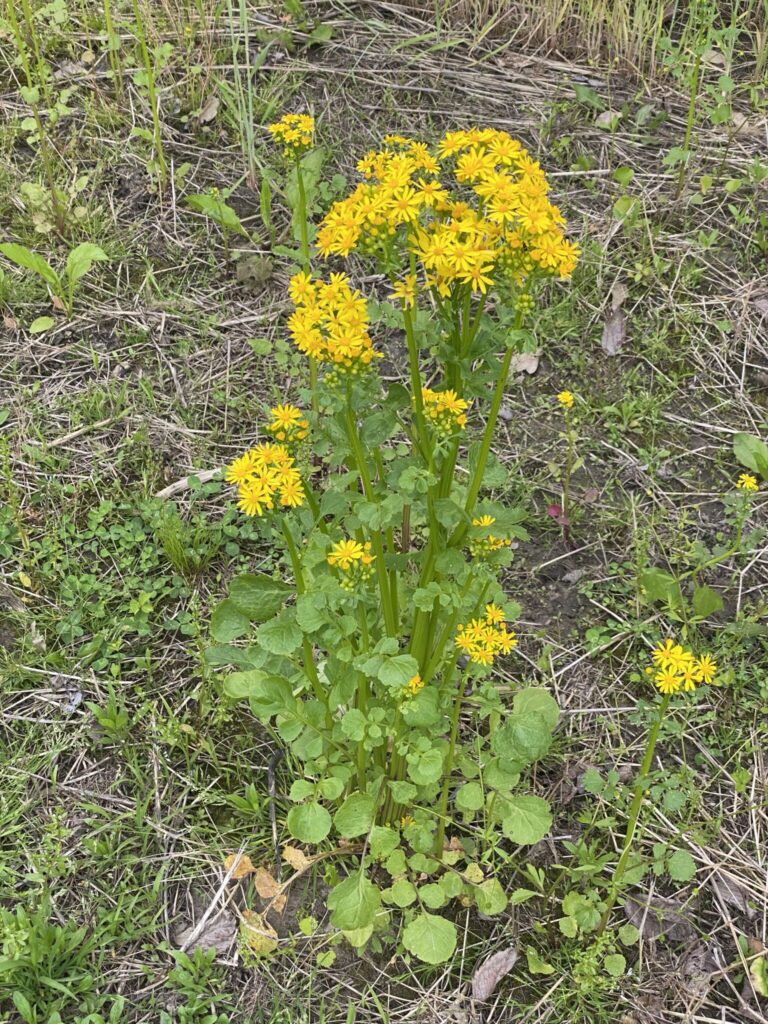Every spring we receive several calls and e-mails about a certain 3-foot tall weed with yellow flowers (Figure 1). The most common yellow-flowered weeds we have in Indiana are cressleaf groundsel, the buttercup species, and dandelion. Occasionally, we have some fields of canola or rapeseed in the state. But, by far the most prevalent specie we see in no-till corn and soybean fields, and occasionally pastures, is cressleaf groundsel. I have only rarely observed wild mustard in Indiana. Wild mustard is more common in the northern tier of states near the Canadian border. This year, field activities were delayed due to cool temperatures and frequent precipitation. These weather conditions also allowed cressleaf groundsel to reach the reproductive stage, and it is currently flowering in many Indiana fields that haven’t been worked yet. This article is intended to provide information on the biology and life cycle of cressleaf groundsel, as well as how to control it in fields and pastures.
Biology and Identification
Cressleaf groundsel is a winter annual weed that has become more prevalent in Indiana pastures and agronomic crop ground over the past decade (Figure 2). The small seeds produced by this weed allow it to thrive in reduced and no-till systems as well as poorly established pastures. Cool and wet springs of the past few years have also favored cressleaf groundsel, as it is a weed that prefers moist soils and typically struggles in hot and dry weather.
Much like most winter annual weeds, cressleaf groundsel emerges as a rosette in the fall then bolts, flowers, and produces seed in the spring. Basal rosette leaves are deep pinnate serrations with roundly lobed leaf margins (Figure 3). Leaves are typically 2 to 10 inches in length (Britton and Brown 1970). Bolting stems are hollow and can reach up to three feet in height with inflorescences that contain six to twelve yellow ray flowers that are often compared to the flowers of common dandelion (Figure 4). When looking for cressleaf groundsel in older weed id or taxonomic guides be aware that it has traditionally been placed in the Senecio genus and only recently was placed into the Packera genus.
Toxic Properties
The competitiveness of cressleaf groundsel with agronomic crops has not been researched, though its presence as a winter annual in no-till fields will have the same implications of slowing soil warming and drying as other winter annual weeds. The presence of this weed in pastures and hayfields should be of more concern as it does contain toxic properties when ingested by livestock. Leaves, flowers, and seeds of cressleaf groundsel contain alkaloids that will cause liver damage in livestock, which is termed seneciosis, and typically occurs on a chronic level (Kingsbury 1964). Symptoms of seneciosis are loss of appetite, sluggish depressed behavioral patterns, and in extreme cases aimless walking without regard to fences or structures. Although cressleaf groundsel is not as toxic as many of its relatives in the Packera genus, livestock producers encountering this weed in pastures or hay should take steps to avoid prolonged ingestion by animals.
Control
Herbicide applications for cressleaf groundsel control are most effective when applied to plants in the rosette stage. Plants that are larger, or bolting are very difficult to control with herbicides. Infestations in pastures can be controlled with 2,4-D or a combination of 2,4-D and dicamba applied to rosettes in the fall or early spring prior to bolting (Nice 2008). Producers should be aware that applications of these herbicides will also kill favorable broadleaves (legumes) that are present in pastures.
Control recommendations for cressleaf groundsel in no-till agronomic crop fields have typically been to apply 2,4-D @ 1 qt/A to actively growing rosettes in the fall. Research at the University of Illinois (Lake and Hager 2009) has shown that fall or spring applications of glyphosate (Roundup PowerMax II @ 22 to 44 oz/A plus liquid AMS @ 5% v/v) to 2-8 inch diameter rosettes can achieve 94% or greater control of cressleaf groundsel. We have observed that control of cressleaf groundsel with spring burndowns can be challenging if the plants are large and spray applications are made in cool weather. In situations like this, we often observe severe injury and necrosis of leaves, but new growth will appear from live buds on the plant. In some instances, resprays are needed to finish off the cressleaf groundsel.
References:
Britton N and A Brown (1970) An Illustrated Flora of the Northern United States and Canada. Volume 3. Dover Publications, Inc., New York. Pp 540-544.
Kingsbury KM (1964) Poisonous Plants of the United States and Canada. Pentice-Hall, Inc., Englewood Cliffs, N.J. pp 425-435
Lake JT and AG Hager (2009) Herbicide Selection and Application Timing for Control of Cressleaf Groundsel (Packera glabella). Weed Technol. 23:221-224
Nice G (2008) Guide to Toxic Plants and Forages. Purdue Extension Publication WS-37






